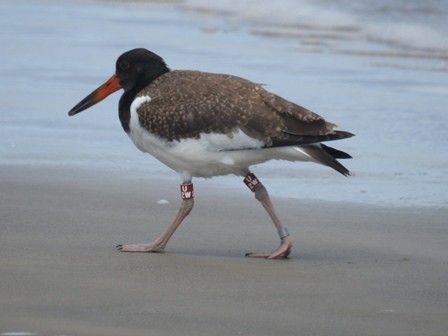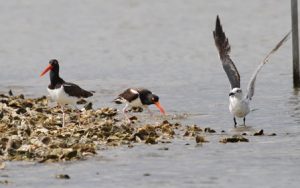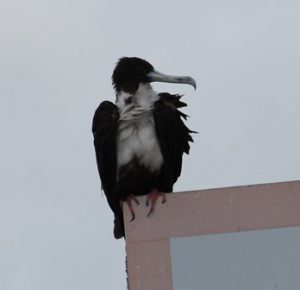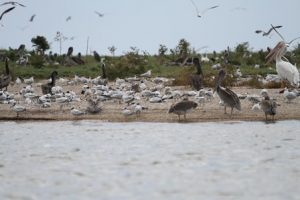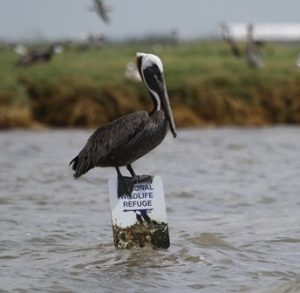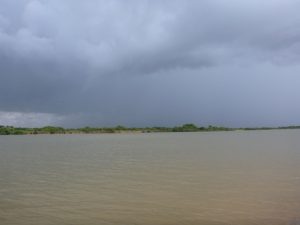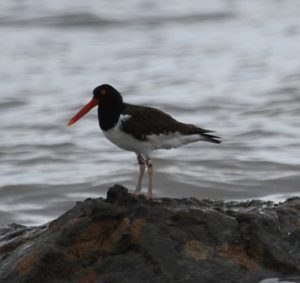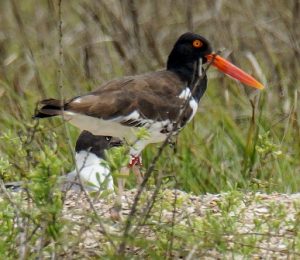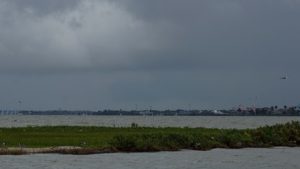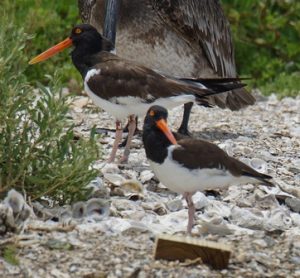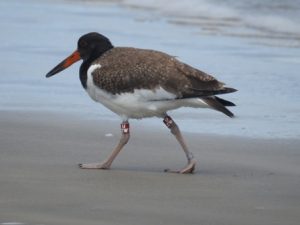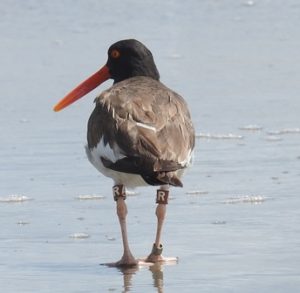By Susan Heath
I finally made it back out to East Matagorda Bay on Monday. The weather was not optimal with many rain storms in the area and ordinarily I would have passed on the trip but this was the only day it was possible. Since I’ve missed so many trips out there and my volunteers were game, we decided to go for it. I was joined by Master Naturalists Pete and Peggy Romfh and American Bird Conservancy Gulf Conservation Program Manager Kacy Ray. I wasn’t expecting to find much. The last time I was out there (May 1) there weren’t any nests or young chicks so a pair would have had to lay a nest, incubate it, raise a chick and have it fledge between May 1st and Tropical Storm Cindy last week which I didn’t think was possible. Additionally, our shorebird technician Amanda Anderson has been seeing a lot of these oystercatchers on the beach at Matagorda Peninsula and so has Master Naturalist Oron Atkins on his turtle patrols so I was pretty sure these birds were done for the year. I just wanted to give it one more check anyway to make sure.
We found one pair at the Chinquapin Islands, KN & unbanded. The other two pairs were missing. KN & unbanded made it clear they didn’t appreciate our intrusion though.
We headed out to Dressing Point and found a frigatebird sitting on one of the shell marker signs.
What a magnificent beast! Look at the bill and those feet. I don’t think I ever paid attention to their feet. Dressing Point was hopping with tern chicks which was good. I guess the tide didn’t go over the island during the storm.
We spotted this guy holding court.
They must have some tough feet. If I tried to stand on something that thin, I’d be in pretty significant pain!
We didn’t find any oystercatchers at the Oyster Farm but man were there a lot of pelicans. They were everywhere! We headed back across the bay eyeing a rain storm to the west. Thankfully it was farther west than we were going. At Old Gulf Cut we found 17 & unbanded with one of their fledged chicks. They had two and I’m sure the other one was just off by itself somewhere. These chicks fledged back in April and I missed banding them because of my kidney stone. Dang!
We stopped at the cut for a while to take a break, eat lunch, and avoid having to go through this.
It passed inland and we were heading out when a very loud thunderclap jolted us out of our nonchalance. Yikes. I had been watching and hadn’t seen any lightning but where there’s thunder… We quickly headed back east towards the boat ramp. Thankfully we made it by the thunderstorm without incident and we found ER on a mud bank about a half mile down the GIWW from his territory. I wonder if he’s scouting around for a new place to nest. His island has eroded so low that there’s little chance he can be successful there. I guess I’ll find out next year.
On Wednesday John Wright, Alan Wilde, myself and Oron Atkins had planned to head out to West Galveston Bay and see what things looked like after the high tides of Tropical Storm Cindy, but when I got up and checked the weather it did not look good. There was a high chance of rain all morning and the radar showed some big storms building just off the coast. The weather forecast showed the chance of rain going down around noon so we decided to wait and see what would happen. Oron and I scrapped our 7:00am departure time and I went to the office. Around 8:30 John texted me that it was beautiful outside and it hadn’t rained at all. Of course. Why do I listen to the weather forecast! Oron and I took off for Galveston about an hour later. By the time we got there, rain storms were threatening again but we decided to head out and see what we could get done.
My biggest priority was to see if the Zimmerman twins (20 & 21’s chicks) had survived the storm. We banded them on our last outing and they were due to fledge within days of banding. Their location is Zimmerman Point thus the name I gave them. We raced across the bay with rain threatening to the east. When we got there we found the whole family standing up on their island! Woohoo! I was elated.
 photo by Alan Wilde
photo by Alan Wilde
Oron helped me get the receiver set up and we quickly checked to see if the nanotag I put on U1W was working. I easily picked up the signal so all was well. We headed back down to West Galveston Bay to get away from the impending rain and headed over to South Deer Island to check on the pair that had a nest there last time. Since we were there, I checked on KK’s nanotag. It was still transmitting. Good deal!
Y7 & unbanded’s territory was covered with young pelicans.
We didn’t see the oystercatchers until we approached closely and then they appeared from somewhere. Their nest was gone though. We checked around the corner for 13 & unbanded because last time I thought they might have chicks but they were not present so no chicks for them. Rain was threatening again so we headed over to North Deer.
JR & JH were standing very near where their nest had been but there was no more nest and no chicks present. The high tides must have gotten that one too.
We went over to Jones Bay and confirmed what Alan suspected after his kayak trip on Monday. 28 & AP’s chick did not survive the high tides. That chick was very small and I was pretty sure it wouldn’t make it. There isn’t much high ground there and I suspect the pelican chicks were all fighting for it. A small oystercatcher chick didn’t have much of a chance against them. Very sad.
We headed back to John’s house to escape the impending rain. An hour later after we ate lunch, it was clear and blue sky. Figures! Oron and I headed back towards home but we stopped in West Galveston and downloaded the Motus data from the tower there. Then we checked the beach on Follet’s Island for oystercatchers. I had banded a chick in Drum Bay about a month ago and hadn’t been able to get back to see if it fledged. The pairs in Drum Bay hang out on the beach along Follett’s Island when the tide is high and the tide was very high today. First we found JT & unbanded, but then we struck gold. JK & unbanded were on the beach with their chick U2W!
I hauled out the VHF receiver one more time and checked the nanotag that I had put on it. It was still transmitting so great news all around and a great way to top off the day. We continued down the beach and found AR & unbanded a little further down.
Their nest had failed the last time I was out in Drum Bay so if they laid another one, it must have failed too. And that folks wraps up another season of oystercatcher monitoring. We made plans to go out again on July 13th just to make sure no pairs managed to sneak a chick by us and to check the nanotags on all the birds that have them. If there’s anything exciting to report, I’ll let you know.
Final Stats for upper Texas coast from Dickinson Bay to East Matagorda Bay: 0 nests being incubated, 63 failed nests, 0 nests with unfledged chicks, 0 nests with undetermined status, 15 chicks fledged
This project is supported by the National Fish and Wildlife Foundation and several private donors. If you would like to contribute you can do so by clicking on the Donate Now button below. All donations are tax deductible and GREATLY appreciated.
Note: All trapping and banding for this project is in accordance with federal and state permits issued to Susan Heath, GCBO Director of Conservation Research. Bird handling by volunteers is only permitted in the presence of Susan Heath and volunteers are trained in proper bird handling techniques.

